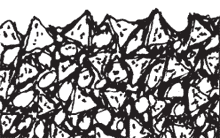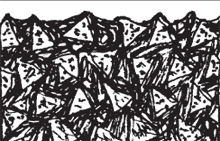Worth knowing
Grit
The grit describes the fineness of a grinding agent. In Europe, it is defined as the number of meshes per square inch of a sieve. Thus, for example, a grinding agent of grit 500 just barely passes through a sieve with 500 meshes per square inch. Occasionally, the grit is also expressed in terms of the grinding particle size in microns (= 1/1000 mm). One uses stones of grit 80-220 for roughing out (coarse shaping, repairing nicks and chips), grit 800-2000 for sharpening, and grit 3000-12,000 for finishing and polishing.
Structure of a synthetic sharpening stone
Sharpening stones are always comprised of a binding agent (matrix), in which the grinding particles (aluminium oxide, carbide, natural semi-precious stones, diamond dust) are embedded. The effectiveness of the stone depends on the combination of hardness of the binding agent and the quality of the grinding particles. As binding agents, claylike substances, the hardness of which can be determined by the composition and the baking temperature, are used with synthetic waterstones.

Open texture
|

Closed texture
|
With most Japanese stones the binding agent is relatively soft and open-porous. During sharpening, fresh grinding particles are continuously released, achieving a high level of effectiveness.
The wear resulting from this process makes the regular trueing of the stone necessary. By comparison, ceramic stones possess a very hard binding agent and little wear. In order to obtain good sharpening performance, however, the use of high-quality, wear-resistant grinding particles (such as with Shapton) is required. In the extreme case of a completely rigid binding of the grinding particles, and thus virtually no wear of the stone whatever, diamonds are used as grinding particles (DMT).
Why not tool sharpening steel?
This serves only for the removal of burrs from conventional kitchen knives up to a hardness of 58 Rockwell. A tool sharpening steel does not sharpen. Tool sharpening steels have a hardness of 60 to 70 Rockwell. They would only scratch Japanese blades or glide use lessly over the surface. For this reason, we do not offer tool sharpening steels in our programme.
Care products
Even after sharpening, every blade still requires proper care. For the prevention of rusting, use an acid-free rust-protection oil, e.g. camellia oil (No. 705280) or Ballistol (No. 705270). For the cleaning of dull or oxidised surfaces, we recommend Gundelputz polishing paste (No. 705262) or Uchiko polishing powder, and for the removal of rust the rust eraser (No. 711530).